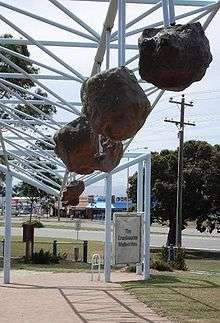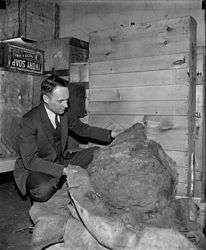Cranbourne meteorite
| Cranbourne | |
|---|---|
|
A fragment of the Cranbourne meteorite called "Pearcedale". | |
| Group | IAB Main group (MG)[1] |
| Country | Australia |
| Region | Victoria |
| Coordinates | 38°6′S 145°18′E / 38.100°S 145.300°ECoordinates: 38°6′S 145°18′E / 38.100°S 145.300°E |
| Observed fall | No |
| Fall date | Unknown |
| Found date | 1854 |
| TKW | 8,600 kilograms (19,000 lb)[1] |
| Strewn field | Yes |
Cranbourne meteorite is an octahedrite iron meteorite. It is the second largest meteorite found in Australia after the Mundrabilla meteorite, but at the time of discovery it was the largest iron meteorite in the world. It is classified as a main group IAB meteorite.[1][2]
Discovery
It is not clear when the first fragments of the meteorite were found. They were first recognized as meteoric in origin at an exhibition in Melbourne in 1854. A piece of fragment "Cranbourne 001" that had been made into a horse shoe was on display there. When investigations were made two masses, Cranbourne 001 and 002 were found buried at their original impact site that had been mistaken as an outcrop of an telluric iron deposit.[2]
Cranbourne 003 was found in 1860. It had been found by a farmhand around 1857 and used as a hotplate. It was later lost in shipping for scientific investigation.[2]
The meteorite may have fallen as recently as 200 years ago.[2]
Fragments

The following table lists all the fragments of the Cranbourne meteorite:
| Fragment | Name | Year found | Mass [kg] | Location |
|---|---|---|---|---|
| Cranbourne 1 | - | ~1853 | 3550 | Natural History Museum |
| Cranbourne 2 | - | ~1853 | 1525 | Melbourne Museum |
| Cranbourne 3 | - | ~1857 | ~6.8 | Lost in shipping |
| Cranbourne 4 | - | 1923 | 1270 | Melbourne Museum |
| Cranbourne 5 | - | 1923 | 356 | Collection of the ministry of primary industries |
| Cranbourne 6 | Pakenham | 1928 | 40.5 | Melbourne Museum |
| Cranbourne 7 | - | 1923 | 153 | University of Melbourne, Department of natural history |
| Cranbourne 8 | - | 1923 | 23.6 | Collection of the ministry of primary industries |
| Cranbourne 9 | Beaconsfield | 1876 | 74.9 | Cut into pieces and sold by mineral dealer. |
| Cranbourne 10 | Langwarrin | 1886 | 914 | Melbourne Museum |
| Cranbourne 11 | Pearcedale | 1903 | 762 | National Museum of Natural History |
| Cranbourne 12 | - | 1927/1982 | 23 | City of Casey |
References
- 1 2 3 "Cranbourne". Meteoritical Society. Retrieved 29 December 2012.
- 1 2 3 4 "The Cranbourne Meteorites" (PDF). City of Casey. Retrieved 29 December 2012.
